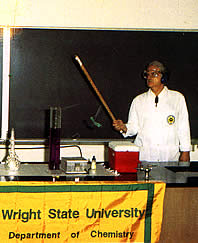| Home | Psychotherapy Vita |
Psychotherapy Workshops |
Chemistry Vita |
Chemistry Presentations |
Books |
Chemistry Presentations
(Revised May 2020)
Contact (for chemistry-related
issues only):Department of Chemistry
Wright State University
Dayton, OH 45435
USA
(937) 767-1854 home/office

| Thermodynamics of Solutions |
Dr. Battino has published more than 90 research papers, primarily on the thermodynamics of solutions. He has also edited three volumes of gas solubility data (Nitrogen and Air, Oxygen and Ozone, and the updated volume on Oxygen and Ozone) for the IUPAC Solubility Data Series. With S.E. Wood, Battino has co-authored an introductory text and an advanced monograph on chemical thermodynamics.
Lectures include:- The High-Precision Solubility of Gases in Water
- A FUN Approach to Thermodynamics
(multimedia presentation for chemistry and general audiences)
- “Mysteries” of the First and Second Laws of Thermodynamics
- Thermodynamics Works! Enthalpy and Heat Capacity Changes on Solution from Gas Solubility Data
- Correlations Involving the Solubility of Gases in Water
- The O2/N2 Ratio Gas Solubility Mystery
| Chemical Education | ▲ |
Dr. Battino has published more than 80 papers on chemical education and has been presenting 15 or more 90-minute shows for school children every year for more than 40 years. (See videos.)
Lectures include:- Interesting and FUN Ways to Teach at University
This motivational talk covers: - The importance of the opening lecture
- Eccentricity
- Expectations
- Whimbey pairs
- The three-minute essay
- Modeling
- Being polite
- The use of skits
- Participatory demonstrations
- . . . and more
- Interesting and FUN Ways to Teach Chemistry
Similar to the previous talk, but with examples taken mainly from chemistry.
- A FUN Approach to Thermodynamics
A multimedia lecture using a dramatic reading, a skit, a movie, audio tape, and simple relevant demonstrations.
| The History of Early Flight | ▲ |
Along with professional model makers H.R. DuFour and J.D. Arehart, Dr. Battino has edited a book entitled An Oral History of Charles E. Taylor, the Wright Brothers’ Mechanician. The book is derived from interviews with people who knew or were related to Taylor, the man who built the Wright Brothers’ engines. The research Battino did for this book (available from the Archives Department in the Wright State University Library) and his long tenure at Wright State have made him knowledgeable about the history of early flight, especially those aspects centering on the Wright Brothers. He offers two 60- to 90-minute illustrated talks on the following subjects:
- The Genius of the Wright Brothers and the Construction of an Accurate
Full-scale Replica of the 1903 Flyer
In addition to recounting personal histories of the Wright Brothers and their families, Dr. Battino will present material showing how scientific the Wrights were in their approach to flying, even fabricating wind tunnels and other aerodynamic testing apparatus in their bicycle shop. He will also detail what he learned by helping to construct a replica of the 1903 Wright Flyer. Along with DuFour and Arehart, Battino received a grant to construct the full-scale replica, which now hangs in the atrium of the Wright State University library. The story of this project provides unmatched insight into the Wright Brothers’ procedures.
- The Three Who Flew at Kitty Hawk: Charlie Taylor and the
Wright Brothers’ Engines
Charles E. Taylor was the mechanical genius who built — in 30 working days — the engine that powered the Flyer in 1903. Using numerous original slides, Dr. Battino will discuss the design and construction of the engine, along with interesting material from Taylor’s life. This talk includes a section entitled “the Flight of the Vin Fiz,” the fascinating story of Calbraith Perry Rodgers, the first man to fly across the United States. Taylor was Rodgers’s mechanician for this historic flight, which he made in 1911 to win a prize of $50,000 offered by William Randolph Hearst. Rodgers ultimately did not win the prize, but he made aviation history.
| SITE DESIGN BY BATMOSPHERE | ▲ |